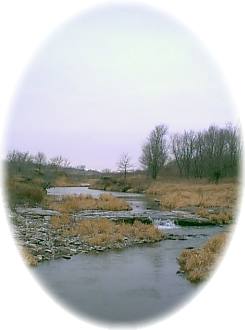Weeping Water, Nebraska

An Indian legend tells of a battle which began when one tribe stole the daughter of another tribe's chief, and ended three days later when many braves of both tribes were slain. The tears cried by the families of the fallen warriors were said to have formed the "weeping waters." For hours and hours they wept until their tears began to make trickling streamlets which flowed down into the valley where they formed a larger stream. The Indians named this stream "Weeping Water," and it has ever since been flowing. To this day, it is said, you can sit beside the falls of the Weeping Water Creek and hear the weeping and wailing of the Indian squaws and maidens.
A leisurely drive from either Lincoln or Omaha will bring you to the only town in the United States which bears the name "Weeping Water." The unique, heavily wooded town is situated on the creek from which it borrowed its name.
The dense woods surrounding Weeping Water paint a beautiful picture, especially in spring and fall. Hidden among the rolling hills are many wild flowers and rare plants. A few hazelnut trees stand on the side of Cemetery Hill. Local residents refer to Elm Street and North Commercial by their colorful old names - Gospel Hill and Chicken Hollow. Oakwood Cemetery, originally a public burying ground, has many old tombstones and provides a beautiful view overlooking the town. Scenic Drive has as much color in the fall as many Ozarks highways. Other modern points of interest are Brown's Airport which hosts sky-diving events, and several limestone quarries, which produce crushed rock and allied products and provide industrial activity for this otherwise rural community.
For rock hounds, the creek bed, the quarries, and other places where limestone is exposed are sources of interesting fossils. Some rare fossils from this area are included in the fine collection of Morrill Hall (the University of Nebraska State Museum on the Lincoln Campus). The area is also rich in Indian relics. An outstanding collection, much of which is now housed in the museum of the State Historical Society in Lincoln, has been compiled by the late Dr. L.N. Kunkel of Weeping Water, an authority on the area.
A complex known as the Heritage House Museum includes 3 historic buildings which house many displays of Indian artifacts and early Weeping Water memorabilia. The newest museum addition called Memory Lane is located downtown and tells the story of Main Street life in a small town on the Plains before 1930.
Weeping Water celebrates its main industry - limestone - once a year with activities including a parade, ball games, kids' fishing contest, mine tours, rock olympics, street dance, and one of the largest fireworks displays in the county. The summer farmers market and the Cass County fair keep visitors coming to this unique town throughout the summer and fall.
Today as yesterday, the land and the limestone provide the community with its diverse economy. While Germans formed the largest immigrant group in the valley, Weeping Water once had its own "Swede Town," a testimony to the presence of Scandinavian immigrants. Mail boxes still proudly carry the names of those whose ancestors came to till the soil and work in the shops over a century ago. The highest population was 1,350 in 1890, with current figures maintaining about 1,000 residents.
